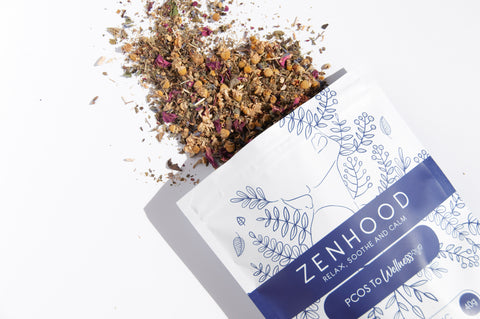[ad_1]

*UPDATE* Our naturopathic formulated adrenal calming herbal tea blend ZENHOOD is officially available for purchase HERE(limited stock available).
What is ADRENAL PCOS, and how can you to treat it?
To find out if you have adrenal PCOS, you first need to confirm you have PCOS.
There are three diagnostic criteria for PCOS and at least two of the following criteria are needed for a definitive PCOS diagnosis:
- Signs or symptoms of high androgens (acne, facial hair, unwanted hair growth or loss)
- Irregular periods
- Polycystic ovaries
Adrenal PCOS is one of the four ‘types’ of PCOS:
1. Inflammatory PCOS
2. Post pill PCOS
3. Insulin resistance PCOS
4. Adrenal PCOS.
You can have one of these ‘types’ of PCOS, or you might find you have a combination of a few.
In this post we will be focusing on ‘Adrenal PCOS’
Some common signs of Adrenal PCOS (combined with the common PCOS symptoms) are:
- Waking up tired
- Stubborn weight gain around mid section
- Tired but ‘wired’ at night
- Increased irritability and anxiety
- Brain fog and lack of focus
Why does this happen?
You have two adrenal glands that sit on top of each kidney and produce stress hormones, like cortisol and adrenaline, and sex hormones like DHEA and testosterone. Stress, whether emotional or physical, causes your adrenal glands to release more cortisol, which inadvertently also increases DHEA-S levels.
DHEA-S is an androgen, like testosterone, but is only produced by the adrenal glands. Between 20 to 30 percent of patients with PCOS have high DHEA-S levels (2). Cortisol and DHEA-S disrupt the balance of other hormones in your body that lead to PCOS symptoms like irregular periods, acne, and unwanted hair growth or hair loss.
Most women with PCOS have a root cause of insulin resistance and high testosterone levels. However, in adrenal PCOS DHEA-S is often the only androgen found to be elevated in a blood test.
If you experience symptoms of PCOS but your labs for insulin resistance and testosterone appear within normal limits, look at your DHEA-S levels. Oftentimes, women with adrenal PCOS only present with high DHEA-S levels.
How to treat adrenal PCOS
The main focus for treating adrenal PCOS is to balance cortisol and reduce DHEA-S levels to within normal limits and encourage healthy hormones and regular periods.
Some things that can help:
- Getting more good quality sleep
- Reduce/ eliminate alcohol and caffeine
- Try supplementing with magnesium, even better have a relaxing bath with our hormone balancing magnesium bath salts
- establish a regular bedtime routine and avoiding electronic screens too close to bedtime
- Practice stress management techinques and find which ones work for you (i.e. some proven methods for lowering cortisol include yoga or tai chi, meditation, spending time in nature, therapy, journaling
- Try powerful stress reducing herbs such as Chamomile, Lemon Balm Passionflower, Tulsi, Lavender & Skullcap – all these powerful herbs are available in our 100% organic ZENHOOD tea
- Try adaptogens such as Ashwagandha which appears to help control mediators of stress and also reduces the activity of the hypothalamic-pituitary-adrenal (HPA) axis, a system in your body that regulates the stress response. Ashwaganda is also one of the ingredients in ZENHOOD tea
- Stick to an anti-inflammatory diet
Key Takeaways: Adrenal PCOS
Adrenal PCOS is a subtype of PCOS that is caused by high levels of DHEA-S and/or cortisol aka – STRESS.
Key interventions to treat adrenal PCOS include sleep, stress management, eating an anti-inflammatory diet and considering herbs such as those found in ZENHOOD tea
ZENHOOD tea is a blend of the highest quality organic and ethically sourced herbs that have been carefully blended to help to:
– Reduce stress
– Soothe adrenals
– Balance hormones + ease symptoms of PCOS
– Calm your mind
– Relax your nervous system
– Promote a restful healing sleep
Comments will be approved before showing up.
[ad_2]
Source link


